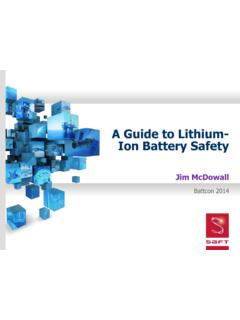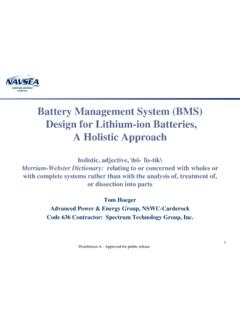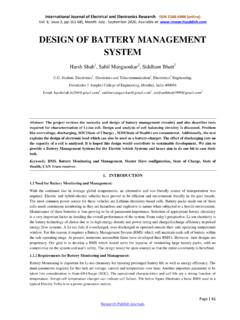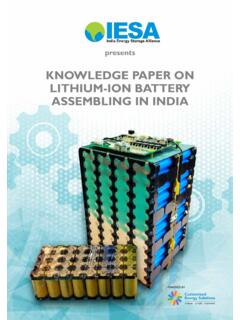Transcription of Eg4 Lithium-ion Battery User Manual - Signature Solar
1 Eg4 Lithium-ion Battery User ManualManual OVERVIEW CONTENTThe EG4 series of lithium iron phosphate Battery modules are designed for Telecom andenergy storage applications. The Battery modules include an integrated, intelligent Battery ManagementSystem (BMS) that monitors, manages, and logs all individual Battery cell parameters, such as voltage, current, temperature, capacity, cell balancing, and state of health for operator safety and module product user Manual describes the type, size, and structure of the Battery modules including BMScharacteristics and module installation Content1. OverviewBackground, Applications and Advantages2. Principle and StructureOperating principles and connecting structures3. ParametersAll Battery module parameters and protections4. Installation and Testing5. Computer SoftwareInstallation, connection and communication6. Shipping, Storage, and Disposal7. Safety, Symbols, and Cautions BEFORE YOU STARTRead all the safety information provided in this document prior to installing or operating theequipment.
2 Contact Customer Support immediately for a free consultation, if you have any questionsabout the handling, operation or safe use of the handle or operate the Battery modules, you shall: Be knowledgeable and qualified to perform electrical work Read the complete user Manual before operating or handling Battery modules Remove any possible metallic shorting risk from your body, such as jewelry, watches, rings,necklaces, etc. All tools shall be insulated1sTable of contents1 2 BACKGROUND AND 2 4 -2 PRINCIPLE AND 6 OPERATING 6 CONNECTING 6 -3 7 7 CONTROL 7 Battery management system BMS ..- 10 VOLTAGE 10 CURRENT 10 TEMPERATURE 11 CELL 11 Battery HEATING AND THERMAL 11 -4 INSTALLATION AND 13 PREPARE TO 13 INSTALLATION OF 13 TOOLS ANd 14 SITE 15 Battery 15 15 15 INSTALLATION 16 -5 PC 19 PC 19 INSTALLATION OF 20 CONNECT AND 20 -6 SHIPPING, STORAGE, AND 21 SHIPPING AND 21 WARNING AND 21 COMMON FAULTS AND 22 -7 SAFETY, SYMBOLS AND 23 SAFETY 23 23 -1 BACKGROUND AND APPLICATIONSThe EG4 series Battery modules are the first Lithium-ion modules for Telecom and energy storageapplications.
3 Lithium-ion batteries are a new generation of green energy batteries. In recent years, therapid advancement of Lithium-ion Battery technology has accelerated the pace to replace traditional lead-acidbatteries. Compared with traditional lead-acid batteries, Lithium-ion batteries boast high energy density, small volume, light weight, long life, and a wide temperature range along with other advantages, particularly safety, with the use of lithium iron phosphate (LiFePO4 or LFP)and intelligent Battery management systems. At present, the lithium iron phosphate Battery technology is very mature, with the cost gradually declining. It is becoming widely used in mainstream and high-end standby power solutions and home energy storage applications and is the preferred Battery technology for communication backup power ADVANTAGES1. High performance LFP cells for long life, safety, and a wide temperature range2. High energy density, small size, light weight, maintenance free, and zero emissions3.
4 LFP cells are connected with fire retardant wire and copper connecting bus bars for stability andsafety4. Built-in BMS, with Battery voltage, current, temperature, and state of health (SOH) management5. LEDs indicate the Battery State of Charge (SOC) and operating status6. Intelligent cell balancing while charging to ensure consistent Battery capacity and extended servicelife7. Optional heating function for use in low temperature environments8. Optional integrated Simple Network management Protocol (SNMP) communication module tosupport remote, dynamic Battery module monitoring9. Standard 19 inch metal rack mount Battery module enclosure for simple installation10. Flexible customization of dimensions11. Easily connect Battery modules in parallel for increased capacity2 PRINCIPLE AND OPERATING PRINCIPLEEG4-48V series Battery modules are primarily used as standby, storage, or backup energy sources. However, Battery modules initially require a charge cycle from some power source (such as utility grid power sources, generators, or Solar photovoltaic (PV) systems) to obtain their cycle capacity.
5 They can then provide continuous power to loads when power sources are disrupted or not available; until their capacity is too low to continue the discharge cycle. Once a power source returns, the Battery module is recharged and the charge/discharge cycle CONNECTING STRUCTUREWhen using more than one EG4-48V series Battery module, it is imperative to use Bus Bars to provide steady and even charging across your Battery bank. 3 MODELSThe EG4-48V series Battery module product specifications are in Table EG4-48V series Battery module productsModel TypeVoltage(V) Capacity EnergyLength widthHeight Weight (Kg) 442mm 435mm 134mm 442mm 470mm 155mm CONTROL PANELEG4-48V series Battery module is shown in figure EG4-48V series Battery moduleTable carrying and handling2 TerminalsConnect to DC bus for charging and discharging3 FixtureRack mount enclosure4 IDAssign address for each moduleSee Table indicates module operationON - StandbyFlashing - charge/discharge6RS485RS485 Communication interface7 BreakerSwitch the module output on/offOptional8 ALMLED indicates Alarm9 SOCThe state of charge4 green LEDs (each designates 25% SOC)
6 10 DODry contact with optocoupler circuitOptional11 FuseEasy-to-replace fusesOptionalTable Assignment of ID addressesCodeAddressAssignRemarks1234 ONONONON0 Module 1 ONONONOFF1 Reserved forInvertercommsONONOFFON2 Module 2 ONONOFFOFF3 Module 3 ONOFFONON4 Module 4 ONOFFONOFF5 Module 5 ONOFFOFFON6 Module 6 ONOFFOFFOFF7 Module 7 OFFONONON8 Module 8 OFFONONOFF9 Module 9 OFFONOFFON10 Module 10 OFFONOFFOFF11 Module 11 OFFOFFONON12 Module 12 OFFOFFONOFF13 Module 13 OFFOFFOFFON14 Module 14 OFFOFFOFFOFF15 Module 15 Note: In Table , the Code designates switch positions for a specific module Address (or ID). The switch position denotes a binary coding scheme where "OFF" (up) is "1" and "ON " (down) is "0". For example, "ON 4ON ON ON" is binary "0000" or decimal Address "0"; "ON ON OFF ON" is binary "0010" or decimal Address "2"; "ON OFF ON ON" is binary "0100" or decimal Address "4", and so on. This allows encoding in the range of 0~15, which can support up to 16 modules in parallel.
7 If more modules are needed in parallel, please contact Signature Solar ; we will design the module to meet your LED indicator descriptionStateWarning/NormalRUNALMSOC LEDD efinition25%50%75%100%OFFOFFOFFOFFOFFOFF OFFAll OFFS tandbyNormalONOFFON as Battery capacity indicatesWarningONFlash 2 ProtectionOFFONC hargeNormalFlash 1 OFFW arning Flash 1 Flash 2 ProtectionOFFOND ischargeNormalFlash 2 OFFW arning Flash 2 Flash 2 ProtectionOFFONBMS failureOFFF lash2 OFFNote: For State of Charge (SOC), each ON LED indicates an increment of 25% : Flash 1 Flash once every ; Flash 2 Flash once every Communication interface definition for front panel RJ45 connectorsDefinitionRJ45B (most common)PIN-1 WHT/ORGPIN-2 ORGPIN-3 WHT/GRNPIN-4 BLUPIN-5 WHT/BLUPIN-6 GRNPIN-7 WHT/BRNPIN-8 BRNCANRS485D+D-BatteryCommFigure Interface on Battery Battery management system VOLTAGE PROTECTION Over VoltageWhile charging, if any individual cell voltage exceeds the cell protection limit or if the Battery module voltageexceeds the module protection limit, the BMS will disconnect the Battery module terminals to shut offcharging.
8 Once all cell voltages and the Battery module voltage have decreased below the set recover limits,the BMS will automatically reconnect the Battery module terminals and allow charging to resume. Thevoltage settings are shown in table Under VoltageWhile discharging, if any individual cell voltage is below the cell protection limit or if the Battery modulevoltage is below the module protection limit, the BMS will disconnect the Battery module terminals to shutoff discharging. Once all cell voltages and the Battery module voltage have increased above the set recoverlimits, the BMS will automatically reconnect the Battery module terminals and allow discharging to voltage settings are shown in table CURRENT PROTECTION Charge Over CurrentWhile charging, if the current exceeds the maximum continuous current rating by 2% and remains for greaterthan 10 seconds, or if the current exceeds the rating by 20% and remains for greater than 3 seconds, the BMSwill disconnect the Battery module terminals to shut off charging.
9 The BMS will automatically reconnect thebattery module terminals and allow charging to resume after 180 seconds. Resolve the fault condition toavoid further shutdowns or the BMS will lock the module after 5 attempts and require a Manual reset. Thesettings are shown in table Discharge Over CurrentWhile discharging, if the current exceeds the maximum continuous current rating by 2% and remains forgreater than 10 seconds, or if the current exceeds the rating by 50% and remains for greater than 3 seconds,the BMS will disconnect the Battery module terminals to shut off discharging. The BMS will automaticallyreconnect the Battery module terminals and allow discharging to resume after 60 seconds. Resolve the faultcondition to avoid further shutdowns or the BMS will lock the module after 5 attempts and require a manualreset. The settings are shown in table Short Current ProtectionWhile discharging, if the current exceeds the maximum continuous current rating by 100% and remains forgreater than 1 second, the Battery module output circuit breaker will trip and disconnect the Battery moduleterminals to shut off discharging.
10 The BMS will require a Manual reset. Resolve the fault condition to avoidfurther shutdowns. The settings are shown in table Reverse Polarity ProtectionIf the Battery module terminals are connected to a load or source with the polarity of the terminals reversed,the BMS will immediately disconnect the Battery module terminals and enter the polarity protection state toprotect the Battery module from damage. The BMS will require a Manual reset. Ensure the terminal polarityerror is corrected before TEMPERATURE PROTECTION CellThere are several thermal sensors to monitor cell temperature. If the temperature of anycell is less than 23F or greater than 158F, the BMS will disconnect the Battery module terminals to terminatecharging. The BMS will automatically reconnect the Battery module terminals and allow charging to resumeafter the temperature returns to within 32F to the temperature of any cell is less than -4F or greater than 167F, the BMS will disconnect the Battery module terminals to terminate discharging.






